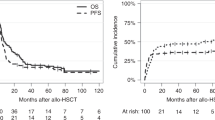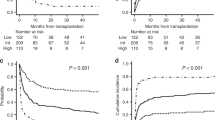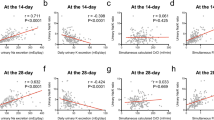Abstract
Transplant-related mortality (TRM) following allo- geneic bone marrow transplantation (BMT) remains a major concern and early identification of patients at risk may be clinically relevant. In this study we describe a predictive score based on bilirubin and blood urea nitrogen (BUN) levels on day +7 after BMT. The patient population consisted of 309 consecutive patients who underwent BMT from sibling (n = 263) or unrelated donors (n = 46) for hematologic disorders between December 1990 and December 1996. Of 27 laboratory tests taken on day +7 after BMT, serum bilirubin (P = 0.02) and BUN (P = 0.007) were found to be independent predictors of TRM in multivariate analysis. The median levels of bilirubin (0.9 mg/dl) and of BUN (21 mg/dl) were then used as a cut-off and a score of 1 was given for values equal/greater than the median. There were 216 patients with scores 0–1 (low risk) on day +7 (bilirubin <0.9 and/or bun <21) and 93 patients with score 2 (high risk) (bilirubin ⩾0.9 and bun ⩾21): the latter had more grade iii–iv acute graft-versus-host disease (P = 0.03), slower neutrophil (P = 0.02) and slower platelet engraftment (P = 0.002). The actuarial 5 year TRM is 22% for low risk vs44% for high risk patients (P = 0.0003). For HLA-identical siblings TRM is 20% vs35% (P = 0.01), for unrelated donors it is 20% vs 65% (P = 0.01). Day +7 score was highly predictive of TRM on multivariate analysis (hazard ratio 1.9, P < 0.01), after adjustment for year of transplant (P < 0.00001), unrelated vs sibling donors (P = 0.001), patient age (P = 0.01) and diagnosis (P = 0.01). These results were validated on an independent group of 82 allogeneic BMT recipients in a pediatric Unit who showed an actuarial TRM of 16% for low risk vs 46% for high risk patients (P = 0.002). This study suggests that it may be possible to identify patients with different risks of TRM on day +7 after BMT: high risk patients could be eligible for programs designed to intensify prophylaxis of post-transplant complications.
This is a preview of subscription content, access via your institution
Access options
Subscribe to this journal
Receive 12 print issues and online access
$259.00 per year
only $21.58 per issue
Buy this article
- Purchase on Springer Link
- Instant access to full article PDF
Prices may be subject to local taxes which are calculated during checkout
Similar content being viewed by others
Author information
Authors and Affiliations
Rights and permissions
About this article
Cite this article
Bacigalupo, A., Oneto, R., Bruno, B. et al. Early predictors of transplant-related mortality (TRM) after allogeneic bone marrow transplants (BMT): blood urea nitrogen (BUN) and bilirubin. Bone Marrow Transplant 24, 653–659 (1999). https://doi.org/10.1038/sj.bmt.1701953
Received:
Accepted:
Published:
Issue Date:
DOI: https://doi.org/10.1038/sj.bmt.1701953
Keywords
This article is cited by
-
Risk factor for death in hematopoietic stem cell transplantation: are biomarkers useful to foresee the prognosis in this population of patients?
Infection (2014)
-
Biomarkers for acute GVHD: can we predict the unpredictable?
Bone Marrow Transplantation (2013)
-
Pre-emptive treatment of acute GVHD: a randomized multicenter trial of rabbit anti-thymocyte globulin, given on day+7 after alternative donor transplants
Bone Marrow Transplantation (2010)
-
Vascular endothelial growth factor (VEGF) is associated with reduced severity of acute graft-versus-host disease and nonrelapse mortality after allogeneic stem cell transplantation
Bone Marrow Transplantation (2006)
-
Reply to the letter by M Ayas
Bone Marrow Transplantation (2003)



